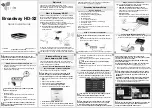
6
ENGLISH
FRANÇAIS
DEUTSCH
NEDERLANDS
ESP
AÑOL
IT
ALIANO
POR
TUGUÊS
SVENSKA
FRONT PANEL CONTROLS FIGURE 2
1 Power On/Off (TNR 1 Figure 3) -
POWER switches the tuner on
or off. Pressing the Power switch turns the Tuner on, the Display
Panel and Power Status Indicator (No. 2) will light up. Pressing the
Power button again will switch the unit off.
NOTE
The C 425 has a receiver for remote control commands built-in. Most
NAD system remote control handsets with an On/Off toggle button
or separate On and Off button will be able to switch the tuner from
On to Stand-by and vice-versa.
The C 425 uses a memory back-up system to store Preset
information. This information is retained for several weeks, even if
the unit is switched off completely or unplugged. When switching
power On, the C 425 will go back to the station last tuned to before
the unit was turned off. This will allow you to make timer recordings
using an external timer and recorder.
2 Power Status Indicator -
The Power Status Indicator will light up
green when Power is on. When the tuner is switched to Stand-by
mode (through either a remote control or the 12V trigger input) the
indicator will light up amber. When the unit is switched off
completely, it is off.
3 Blend (TNR 1 Figure 3) -
Weak or remote stereo radio stations
are sometimes received with noise and hiss as the antenna signal is
too weak. By switching the tuner to mono will reduce the amount of
noise and hiss but at the expense of any stereo information. The NAD
Blend feature will allow you to reduce the amount noise and hiss but
still retain some level of stereo separation, instead of mono. The
Blend button toggles between engaging or disengaging the Blend
feature; when engaged, "BLEND" lights up in the display.
NOTE
The "Blend" status can be stored for individual presets. Refer to the
separate chapter "Storing, Recalling and Labelling Presets" for more
information.
4 Memory -
The Memory is used to store stations into the Preset
Memory bank and to store user defined names for non-RDS Preset
stations. When Memory is pressed during normal operation, the
Preset number and the red "MEMORY" indicator will flash in the
Display Panel. If no other buttons are pressed within 12 seconds, the
tuner will revert to its previous state. Refer to the separate chapter
"Storing, Recalling and Labelling Presets" for more information.
5 FM Mute/Mode (TNR 1 Figure 3) -
This button combines two
functions; it switches the tuner from Stereo to Mono and disengages
the muting circuitry at the same time. The muting circuit will mute
the tuner in between radio stations when searching or tuning. This
way the tuning noise is avoided. The muting circuit however may
suppress very weak radio station signals. If a weak station is in stereo
it will have a high level of background hiss. Switching to Mono Mode
and disengaging the muting circuit by depressing the FM
MUTE/MODE button will allow the station to be heard and will cancel
most or all of this background noise.
In normal operation the mute circuit is engaged, the display indicates
"FM MUTE". Press the FM Mute/Mode button to disengage the
muting circuit and switch from stereo to mono reception. "FM
MUTE" in the display will extinguish. Press the FM Mute/Mode switch
again to return to Auto Stereo FM operation.
NOTE
The "FM Mute/Mode" status can be stored for individual presets.
Refer to the separate chapter "Storing, Recalling and Labelling
Presets" for more information.
6 AM/FM (TNR 1 Figure 3)-
The AM/FM button switches the tuner
from the AM band to the FM band and vice-versa. The Display Panel
shows the frequency of the tuned station and which band is selected.
The FM tuning is in 0.05 MHz increments, AM tuning is in 9 kHz or
10 kHz increments, depending on the version.
7 Display (TNR 1 Figure 3)-
With stations carrying RDS
information, The Display button scrolls between three different
display modes, each successive push of the button engages the next
one of the three modes:
a)
In the default mode, the station’s RDS name is displayed, Program
Service (PS; normally the station’s calling letters, BBC R3, for
instance).
b)
From the default mode, press the button once to view Radio Text
(RT). This can be additional information such as the presenter’s or
program’s name; what song is playing, etc. This text scrolls
continuously over the 8 alphanumeric display segments.
c)
Press the button from the display RT mode to display the station
frequency. Press again to return to the default mode (a).
When tuned to a non-RDS station
- The Display button toggles
the display to show either the station frequency or user entered
station name. If no user name was entered the display will indicate
"NO RDS". The Display button is also used to label non-RDS stations
with a name. Refer to the separate chapter "Storing, Recalling and
Labelling Presets" for more information.
Introduction
C425 072006.qxd 7/28/2006 11:31 AM Page 6
Summary of Contents for C 425
Page 27: ...27 ENGLISH FRAN AIS DEUTSCH NEDERLANDS ESPA OL ITALIANO PORTUGU S SVENSKA...
Page 35: ...35 ENGLISH FRAN AIS DEUTSCH NEDERLANDS ESPA OL ITALIANO PORTUGU S SVENSKA...
Page 43: ...43 ENGLISH FRAN AIS DEUTSCH NEDERLANDS ESPA OL ITALIANO PORTUGU S SVENSKA...
Page 51: ...51 ENGLISH FRAN AIS DEUTSCH NEDERLANDS ESPA OL ITALIANO PORTUGU S SVENSKA...
Page 67: ...67 ENGLISH FRAN AIS DEUTSCH NEDERLANDS ESPA OL ITALIANO PORTUGU S SVENSKA...







































